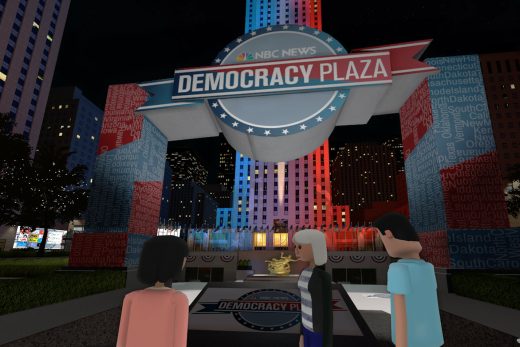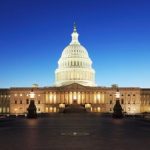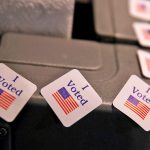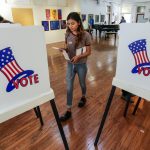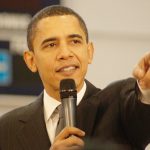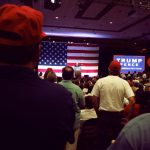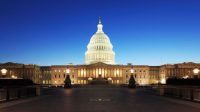Tech Transforms the Election Experience, From VR to Voter Registration
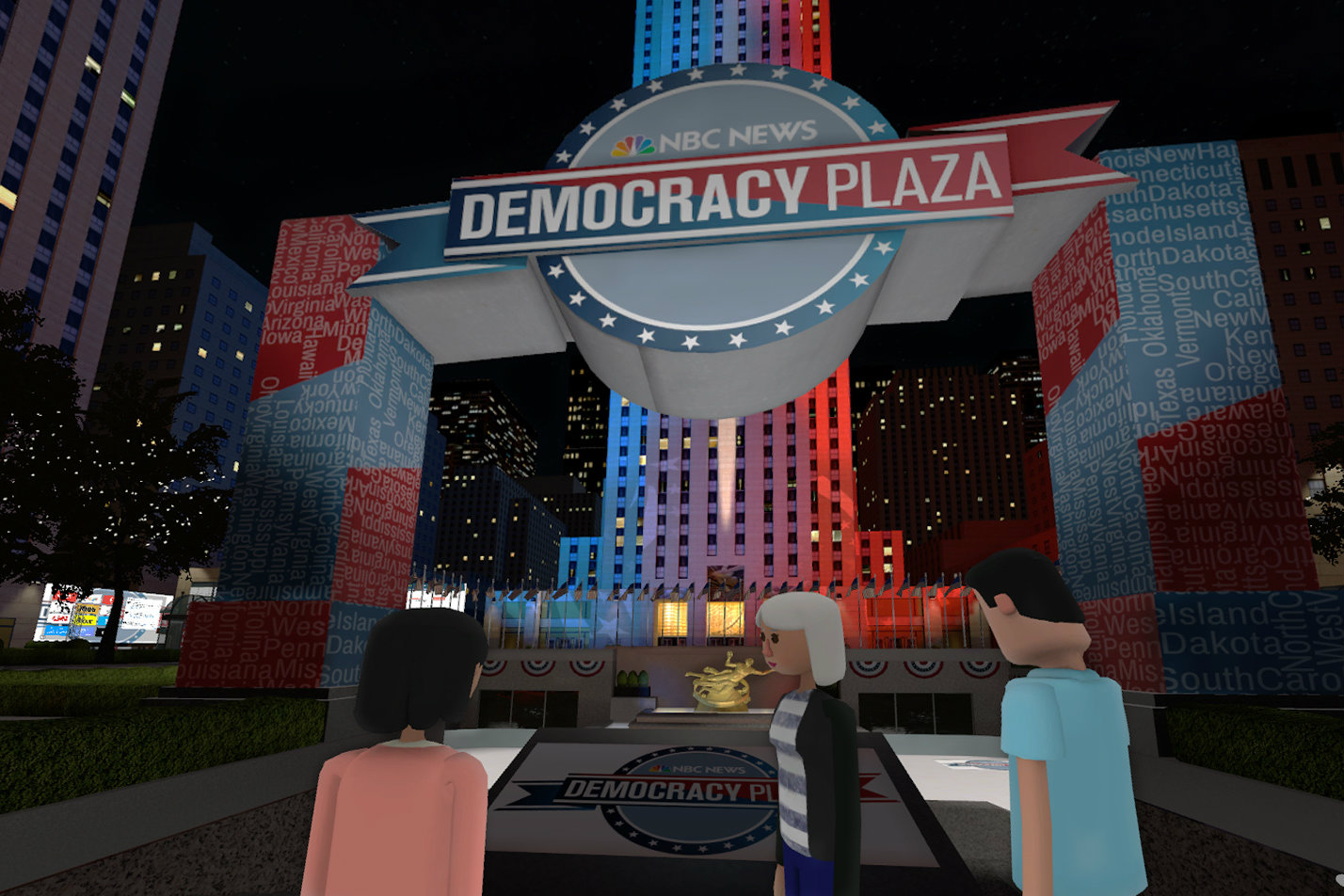
My friend Eileen and I are planning to “phone-watch” the first presidential debate together on Monday. Just by calling her number in Louisiana from my couch in the Bay Area, I’ll hear hilarious commentary on the Clinton-Trump exchange from Eileen, a terrific reporter who’s wittier than most standup comics.
I found another name for this low-tech form of long distance TV show sharing in the New York Times: “sync-watching.” Beyond a simple phone call, far-flung friends are using any technical means possible—like Skype and live tweeting—to duplicate that cozy experience of sitting in front of the same TV together.
This is only one of the ways social media and other technologies are changing the experience of forming our views on election issues and choosing our candidates. Tech will probably reinforce our entrenched opinions on politics to some extent—but it may also expand our worldviews and ease access to the voting process. This year for the first time, virtual reality is part of the mix because VR headsets are now widely available.
A Bay Area virtual reality startup is about to add new dimensions to the sync-watching experience for viewers of NBC News’s coverage of events leading up to the presidential election on Nov 8.
AltspaceVR has created a virtual replica of NBC’s Democracy Plaza in New York’s Rockefeller Plaza, the backdrop for network anchors during the debates and on election night. Political junkies will be able to invite their friends to join them in Virtual Democracy Plaza for NBC’s four virtual debate watch parties, political comedy shows, and the vote count drama the night of the election.
Viewers can check out the virtual venue even if they don’t have VR headsets, by going to altvr.com/nbcnews via their PC or Mac. But headset users who join AltspaceVR will have some interesting social options.
If they don’t want to attend a debate-watching party with people of a different political stripe, they can sign up to share it only with their like-minded pals (appearing as avatars, but audible in their own voices.) AltspaceVR can clone the venues it creates—including Virtual Democracy Plaza—so users can choose to inhabit that venue with a bipartisan crowd or with only a single friend if they like. (See how it works here.)
Redwood City, CA-based AltspaceVR is just one of the tech companies that’s trying to draw in more users or customers by creating new projects that put an election spin on their core offerings.
MediaScience, a market research company based in Austin, TX, tries to detect hidden attitudes among members of test panels by capturing their facial expressions, eye movements, heart rate, and other biometric characteristics. MediaScience has mainly worked for companies such as Disney and ESPN, but this year it’s been inviting its panelists to watch videos of Clinton and Trump, the Austin American-Statesman reported. The use of biological metrics and neuroscience in marketing is starting to expand to political research and campaign strategy-making.
Educational technology company Newsela, which creates multiple versions of news articles geared to varying student reading levels, is recruiting teachers to get kids interested in reading election stories by giving them the chance to vote for their favorite candidates in Newsela’s unofficial student polls. Voting opens for the school kids on Oct. 17 and closes Nov. 1, a week before the grownups vote. Newsela plans to release the results of the student election on Nov. 2 so the students can talk about them in class or with their parents. Then they can compare their generation’s verdict with the outcome of the adult vote on election night.
New York-based Newsela aims to offer youngsters straight news without a partisan spin. But if adults want to immerse themselves in the battle of opinions, there’s a new app on the market.
Menlo Park, CA-based Aleya Labs timed the launch this month of its first consumer app, political news and commentary site Contempo, so it would debut in the final weeks before the presidential election. Aleya says Contempo presents a selection of news and opinion items culled from multiple sources on both sides of the political spectrum. The items are chosen based on their social media rankings among “political influencers” from both the conservative and liberal camps. These influencers include bloggers, columnists, think tanks, and satirists.
Users can read articles from both political factions if they want to break out of their personal filter bubbles. But they can also choose only the items that dovetail with their existing views—literally by swiping to the left or to the right. For further convenience, the stories are actually labeled in red or blue.
On another front, technology is changing the way we influence the polls that try to predict the likely outcomes of elections. News stories on the fluctuating leanings of the electorate used to cite surveys by traditional pollsters such as Gallup, which routinely relied on phone calls to landlines. But that method was losing reliability due to lower response rates, as well as the movement toward mobile phones.
Election poll stories now often cite online surveys conducted by companies such as Palo Alto, CA-based SurveyMonkey, which is collaborating with NBC News. For example, their poll this week showed Democratic presidential candidate Hillary Clinton regaining a narrow lead against her Republican rival Donald Trump.
SurveyMonkey gives anyone the chance to poll others on topics as mundane as favorite cheesecake recipes among family members. But its paying customers can conduct sophisticated custom surveys for market research and other business projects. In the process of hosting all these polls, SurveyMonkey says it has compiled contact information for almost three million people who can be sorted into categories, such as registered voters. Those selected can be asked to answer questions about their views on the candidates.
SurveyMonkey jumped into the election arena late last year, betting that its samplings of survey participants might better represent the American voting population than responders to traditional telephone polls.
Its competitor, Google market research unit Google Consumer Surveys, had already been using its online and mobile surveying methods in the prior presidential election. In this campaign season, it was chosen by GOP-linked research firm Echelon Insights to track voters’ views of the Republican presidential primary candidates, and to plumb the reasons behind Donald Trump’s appeal.
Polls are only predictive to the extent that their participants actually get out and vote—and technology has been playing a role in that arena too. The first step there is reducing the hassle of registering.
Washington, DC-based non-profit Rock the Vote has been offering online voter registration on its own site, as well as providing the same service as a customizable, white-label feature for other organizations. Non-partisan Rock the Vote estimated this month that it has gotten almost seven million voters registered by working with more than 25,000 partners. Among Rock the Vote’s partners are Newsela and Aleya Labs.
Tech-assisted voter registration now extends to mobile phones in Pennsylvania. Rock the Vote worked with partners to create a free Pennsylvania Voter Registration App. The Android app feeds registrations straight into the Pennsylvania Department of State’s voter rolls though the agency’s Web API.
But what about the act of voting itself?
Technology companies such as San Diego-based Everyone Counts are trying to make online voting possible, but we’ll have to wait at least another four years before mass voting from devices at home helps determine who gets to be president.
Everyone Counts has developed software for an online voting system that would allow citizens to vote using off-the-shelf tablet computers. The company announced in late August that its system, called eLect Quad Audit, completed testing by a federally accredited voting system test lab that uses the latest federal voting system standards.
But that came too late to affect many voters in the upcoming election, because local election officials wouldn’t have had time to acquire the system and get it up and running. However, the Everyone Counts system can be used this year by U.S. military personnel and civilian voters overseas.
Once the current election is over, there may be an opening for such companies to sell their online voting technology. But the method is still embroiled in controversy, because some experts doubt that online systems can ever be made secure from hackers who want to disrupt an election or engineer a victory for the candidate they favor.
Election officials, however, can look to tech firms for a little help with managing the complex process of conducting an election this year.
Former North Carolina company EasyVote Solutions, now based near Atlanta, is marketing a Web-based software system that organizes all the chores related to elections, from scheduling poll workers to receiving campaign finance reports from candidates.
For jurisdictions using paper ballots, Boston-based Clear Ballot offers an optical scanner that captures an image of each ballot—ambiguous markings and all—and extracts data on the vote count. In contested elections, the paper ballots can always be resurrected from storage and checked by hand.
So if we’re not lucky, we might still be sync-watching comedy skits about “hanging chads.”
(18)

